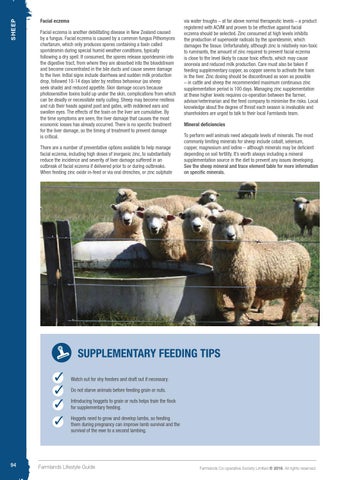S HE E P
Facial eczema Facial eczema is another debilitating disease in New Zealand caused by a fungus. Facial eczema is caused by a common fungus Pithomyces chartarum, which only produces spores containing a toxin called sporidesmin during special humid weather conditions, typically following a dry spell. If consumed, the spores release sporidesmin into the digestive tract, from where they are absorbed into the bloodstream and become concentrated in the bile ducts and cause severe damage to the liver. Initial signs include diarrhoea and sudden milk production drop, followed 10-14 days later by restless behaviour (as sheep seek shade) and reduced appetite. Skin damage occurs because photosensitive toxins build up under the skin, complications from which can be deadly or necessitate early culling. Sheep may become restless and rub their heads against post and gates, with reddened ears and swollen eyes. The effects of the toxin on the liver are cumulative. By the time symptoms are seen, the liver damage that causes the most economic losses has already occurred. There is no specific treatment for the liver damage, so the timing of treatment to prevent damage is critical. There are a number of preventative options available to help manage facial eczema, including high doses of inorganic zinc, to substantially reduce the incidence and severity of liver damage suffered in an outbreak of facial eczema if delivered prior to or during outbreaks. When feeding zinc oxide in-feed or via oral drenches, or zinc sulphate
via water troughs – at far above normal therapeutic levels – a product registered with ACVM and proven to be effective against facial eczema should be selected. Zinc consumed at high levels inhibits the production of superoxide radicals by the sporidesmin, which damages the tissue. Unfortunately, although zinc is relatively non-toxic to ruminants, the amount of zinc required to prevent facial eczema is close to the level likely to cause toxic effects, which may cause anorexia and reduced milk production. Care must also be taken if feeding supplementary copper, as copper seems to activate the toxin in the liver. Zinc dosing should be discontinued as soon as possible – in cattle and sheep the recommended maximum continuous zinc supplementation period is 100 days. Managing zinc supplementation at these higher levels requires co-operation between the farmer, advisor/veterinarian and the feed company to minimise the risks. Local knowledge about the degree of threat each season is invaluable and shareholders are urged to talk to their local Farmlands team. Mineral deficiencies To perform well animals need adequate levels of minerals. The most commonly limiting minerals for sheep include cobalt, selenium, copper, magnesium and iodine – although minerals may be deficient depending on soil fertility. It’s worth always including a mineral supplementation source in the diet to prevent any issues developing. See the sheep mineral and trace element table for more information on specific minerals.
SUPPLEMENTARY FEEDING TIPS 3 3 3 3
94
Watch out for shy feeders and draft out if necessary. Do not starve animals before feeding grain or nuts. Introducing hoggets to grain or nuts helps train the flock for supplementary feeding. Hoggets need to grow and develop lambs, so feeding them during pregnancy can improve lamb survival and the survival of the ewe to a second lambing.
Farmlands Lifestyle Guide
Farmlands Co-operative Society Limited © 2016. All rights reserved.
